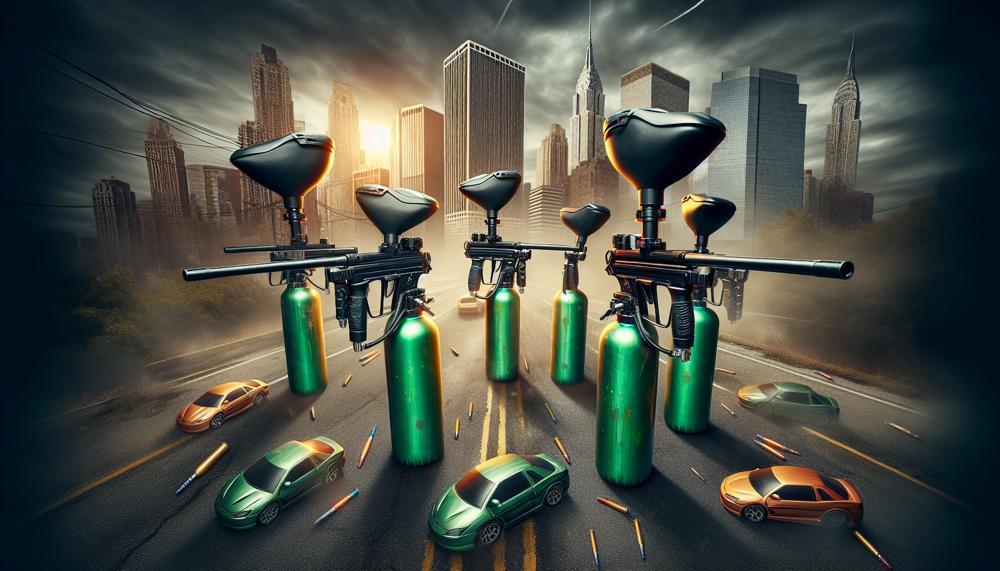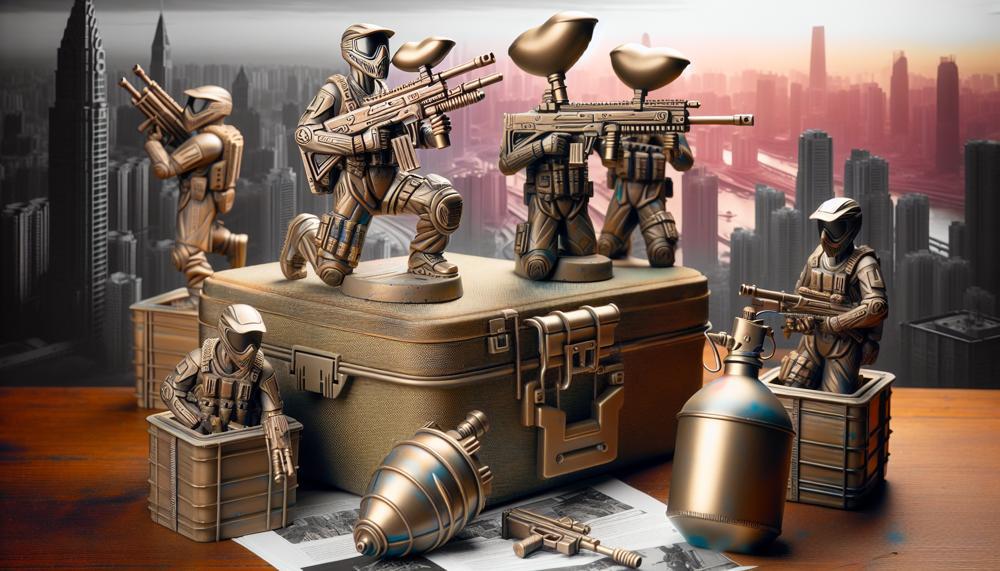Are you ready to take your game to the next level? Then let’s talk about one of the most crucial pieces of equipment – the hopper.
Whether you’re a newbie or a seasoned pro, choosing the right hopper can make or break your performance on the field.
So, buckle up and join us as we explore the various types of paintball hoppers available.
In this post, we’ll delve into:
- The purpose and significance of a hopper in the game
- The three main types: gravity-fed, electronic, and force-fed
- The advantages and disadvantages of each type, and which may suit your playing style
- Additional features to consider when selecting a hopper
- Tips for proper maintenance to ensure top-notch performance
Say goodbye to frustrating jams and running out of ammo at crucial moments. Keep reading to discover which hopper will elevate your game. Let’s get started.
Table of Contents
Different Types of Paintball Hoppers: A Comprehensive Guide
There are several types of paintball hoppers to choose from. Each type has its own unique features and advantages. In this guide, we’ll take a closer look at the different types of hoppers and what sets them apart.
| Hopper Type | Description | Advantages |
| Gravity-fed | The most basic type of hopper that uses gravity to feed paintballs into the marker. | – Affordable – Simple design – No need for batteries – Suitable for casual players – Compatible with any marker |
| Electronic (Force-fed) | The most reliable type of hopper that utilizes a motor to agitate and feed paintballs into the marker. | – Fast feeding rate – Consistent feeding – Suitable for competitive players – Compatible with most markers |
| Agitating | A step up from gravity-fed hoppers, these use a paddle or agitator to assist in feeding paintballs into the marker. | – More reliable than gravity-fed hoppers – Affordable price range – Suitable for intermediate players |
| Low-profile | Designed to sit lower on the marker, providing a sleeker profile and reducing your target size. | – Compact and lightweight – Enhances maneuverability – Suitable for speedball players |
| High-capacity | Can hold a larger number of paintballs, reducing the need to reload frequently. | – Ideal for longer games or scenarios – Reduces downtime and reloading time – Suitable for scenario or woodsball players |
| Split-feed | Have separate compartments for different types of paintballs, allowing you to switch between them quickly during gameplay. | – Ideal for longer games or scenarios – Reduces downtime and reloading time – Suitable for scenario or woodsball players |
| Thermal | Designed to maintain a consistent temperature, preventing paintballs from getting too cold and breaking inside the hopper. | – Reduces chances of paintballs breaking inside the hopper – Suitable for colder climates or scenarios where markers are exposed to extreme temperatures |
Gravity-Fed Paintball Hoppers
Gravity-fed paintball hoppers are a commonly used type of hopper in paintball markers. They are the most basic and traditional option, functioning by relying on gravity to feed paintballs into the marker as players shoot. These hoppers are placed on top of the marker, with a small opening at the bottom where the paintballs can fall into the feed neck.
This straightforward design makes them a cost-effective and beginner-friendly choice. However, they do have limitations, such as a smaller capacity and a tendency to jam if not used correctly.
The feed tube is a key component of a gravity-fed hopper. It ensures that only one paintball can enter the marker at a time. This prevents potential jamming or double-feeding. Unlike other hoppers, gravity-fed ones do not have any electronic components or motorized mechanisms. This makes them a reliable choice for players who prefer a simpler setup.
Players may need to refill frequently during games. They must keep their markers upright and free from obstructions in the feed tube to avoid paintball blockages.
Electronic Paintball Hoppers
Electronic paintball hoppers have various advantages over traditional gravity-fed hoppers. This makes them a popular choice among experienced players. The benefits include a quicker firing speed and more reliable performance. The marker is compatible with electronic markers, has programmable features, and a larger capacity. This leads to an enhanced playing experience.
One of the main perks of using electronic paintball hoppers is their increased firing speed. These hoppers can fire up to 15-20 balls per second, compared to only 10-12 balls per second with gravity-fed hoppers. This allows players to shoot more paintballs in a shorter amount of time, giving them an advantage on the field.

In addition to faster firing speed, electronic-fed hoppers offer more dependable performance. They use motorized paddles and advanced technology to consistently feed balls into the firing chamber. This reduces the risk of misfeeding or jamming. This means players can focus on their game without worrying about their hopper malfunctioning.
For those who own electronic paintball guns, using an electronic-fed hopper is the best choice for optimal performance. These hoppers are designed to work seamlessly with electronic markers. They provide a smoother and more efficient gameplay experience.
Some electronic-fed hoppers also have programmable features, allowing players to set automatic firing once attached to a gun. This eliminates the need for constantly pulling the trigger and allows players to focus on their aim and strategy.
Furthermore, electronic-fed hoppers typically have a larger capacity than gravity-fed hoppers. Many modern electronic paintball guns can empty a fully loaded hopper within 10 seconds. So, you need a larger capacity hopper, like those found in electronic-fed options.
Lastly, using an electronic-fed hopper can enhance the overall playing experience. Popular options on the market include the Dye Precision Loader Rotor R2, Proto Primo, Virtue Spire IR, Empire Halo Too, and Virtue Spire III. These hoppers offer consistent firing. They never disappoint, giving players an edge on the field.
Force-Feed Paintball Hoppers
In the game of paintball, the most advanced type of hopper is the force-feed hopper. This type stands out from others because of its motorized paddles or trays. They push paintballs into the marker without jams. This results in faster, more reliable performance.
Experienced players highly favor this type of hopper for its many benefits and improved playing experience.
How does it work?
The force-feed hopper operates using an electronic motor that spins paddles or trays inside. These components physically push the paintballs towards the marker. This creates a consistent feeding rate. This allows players to fire at a faster speed without worrying about potential jams. It thereby improves overall gameplay performance.
Advantages of using a force-feed hopper
- Increased firing speed: With its constant feed of paintballs, players can fire at an accelerated rate, giving them an advantage over their opponents, especially in high-intensity games.
- Enhanced reliability: The motorized paddles or trays ensure a consistent feeding of paintballs into the marker, resulting in a more reliable performance. This reduces the chances of misfires or malfunctions during gameplay.
- Compatible with electronic markers: Force-feed hoppers are specifically designed to work with electronic markers, making them a popular choice among experienced players who prefer these high-tech markers.
- Programmable features: Some force-feed hoppers come with programmable features that allow players to adjust the speed and rate of feeding according to their playing style and game requirements.
- Increased capacity: Most force-feed hoppers have larger capacities than other types, allowing players to carry more paintballs and play for an extended period without frequent reloads.
Conclusion and Final Tips
After thorough research and careful consideration of the relevant factors, here are some crucial tips for selecting the perfect paintball hopper for your gun:
- Take into account the weight and size of the hopper: In the fast-paced game of paintball, it’s crucial to have a lightweight and compact hopper that won’t hinder your movements or weigh you down. Opt for a hopper that is specifically designed for your marker’s size and weight to ensure a proper fit and optimal performance.
- Determine the desired capacity: Paintball hoppers come in various sizes and capacities, ranging from 50 to 300+ paintballs. Consider your style of play and how much ammunition you typically use in a game. Casual players may prefer a smaller capacity hopper. Competitive players may benefit from a larger capacity hopper.
- Check compatibility with your marker: It’s essential to note that not all hoppers are compatible with all markers. Before making a purchase, ensure that the hopper you’re interested in is suitable for your specific marker. Using an incompatible hopper can lead to jamming or misfires.
- Understand the level of competition you play at: Different types of hoppers are suitable for different levels of competition. Casual players may find gravity-fed or electronic hoppers sufficient. Competitive players often opt for force-fed or high-end electronic hoppers.
- Consider the firing rate: If you have a fast-firing marker, it’s crucial to have a hopper that can keep up with its speed. Force-fed or electronic hoppers are specifically designed to feed paintballs quickly and consistently, making them ideal for high-firing markers.
- Think about your playing style: Your style of play can also impact which type of hopper is best suited for you. If you prefer a more aggressive style, a force-fed hopper will ensure a constant supply of paintballs. You won’t need to shake or tilt the hopper. On the other hand, for more relaxed gameplay, a gravity-fed hopper may suffice.
- Look for durability: Paintball is an intense and rough sport, so it’s crucial to choose a hopper that can withstand the impact and potential damage. Consider hoppers made from sturdy materials, such as polycarbonate or reinforced plastic.
- Decide if you want a gravity-reliant hopper: Gravity-fed hoppers rely on the force of gravity to feed paintballs into the marker. While they are generally less expensive, they may not be suitable for more competitive gameplay as they may not feed fast enough for high-firing markers.
Key Takeaways: Different types of paintball hoppers
Different types of paintball hoppers are gravity-fed, electronic, and force-fed hoppers. Each type has its own features and benefits. The right one for you depends on your playing style, level of competition, and desired capacity.
Gravity-fed hoppers are the most basic and use gravity to feed paintballs into the marker. They are lightweight and simple, making them ideal for casual players or those on a budget. However, they are not as efficient and may cause jams or misfires.
On the other hand, electronic or force-fed hoppers have battery-powered motors that feed paintballs faster. They are reliable and can keep up with high firing rates, making them popular among competitive players. However, they are more expensive and require more maintenance.
Agitating hoppers combine the features of gravity-fed and electronic hoppers by using a combination of gravity and agitation to feed paintballs quickly and reliably. They are a good option for players who want a balance between cost and performance.
Apart from these main types, there are also specialized hoppers available. Low-profile hoppers have a sleek design and sit low on the marker for better maneuverability. High-capacity hoppers are perfect for longer gameplay or intense matches as they can hold more paintballs.
Split-feed hoppers have dual compartments for different colors or types of paintballs. Thermal hoppers have insulated walls to keep paintballs at an optimal temperature.
Conclusion
In conclusion, selecting the right paintball hopper is crucial for taking your game to the next level. It helps you achieve a seamless performance on the field.
Whether you’re a recreational player or an experienced pro, it’s essential to thoroughly understand the various types of hoppers available. This will help you make an informed decision. From gravity-fed to electronic and force-fed hoppers, each one offers unique features and benefits. They cater to different playing styles and preferences.
It is also important to consider factors such as capacity, weight, compatibility with your marker, and level of competition when choosing a hopper. Don’t forget to factor in additional features like programmability and durability as well.
By following these guidelines and keeping in mind the key takeaways from this guide, you’ll be well-equipped to select the perfect paintball hopper for your gun.






